Basque Language



An insatiable appetite for ancient and modern tongues
Address comments and questions to: gutman37@yahoo.com
Alternative name: Euskara, Euskera.
Name Origin. The word Basque derives from Vascones, a nation that in Roman times occupied most of Navarra and northern Aragon in northern Spain.
Classification: Basque is a language isolate. None of the attempts made to relate it to other languages has succeeded.
Overview. Basque is the only surviving language of Western Europe pre-dating the Indo-European expansion. The first evidence of a language similar to Basque dates from Roman times when the Aquitanians lived in south-western Gaul (today's France). Fortunately, some Aquitanian inscriptions have survived, which provide unmistakable evidence of an ancestral form of Basque. From this corner of Gaul, Basque speakers would have migrated southwards to northern Spain.
Basque morphology is primarily agglutinating and, mostly, of the suffixing type. Its native vocabulary is obviously different from those of Indo-European languages. Phonologically, it is unusual for distinguishing between apical alveolar and laminar alveolar sounds. One of its most remarkable features is ergativity, which is not found in the bulk of Indo-European.
Distribution. Today, Basque is spoken in the central area of northern Spain and in neighboring southwestern France. In Spain, mainly in northern Navarra and in the Basque Country (Euskadi), an autonomous community composed of the provinces of Guipúzcoa, Vizcaya, and Álava. In Guipúzcoa, Basque is the maternal language of more than one-third of its population, in Vizcaya of 13 % and in Álava (where is only spoken in the north) of 4 %. In medieval times, Basque was also spoken further south, in La Rioja and Burgos. In France, it is spoken in the western half of the Département des Pyrénées-Atlantiques.
Speakers. Around 720,000 of which 93 % live in Spain and 7 % in France. Almost all Basques are bilingual in either Spanish or French.
Status. In the Basque Country, where Basque is co-official with Spanish, the number of speakers is growing because it is taught at school. In Navarra, Basque has some official recognition. In France only a small percentage of children are learning the language.
Varieties.
-
Unified Basque (Euskara Batua): the standard language based on the literary tradition, used in education and the media.
-
Dialects: there are colloquial varieties whose boundaries go beyond those of the provinces where they are spoken, and are not even uniform in their region. They differ from the Standard (Euskara Batua) and among them, in phonological and morphological features. These dialects are: Vizcayan, Guipuzcoan, Northern High Navarrese, South High Navarrese, Labourdin, Western Low Navarrese, Eastern Low Navarrese and Souletin.
Oldest Documents
-
•Inscriptions with proper names (mostly of persons and gods), and a few adjectives and suffixes, found in the territory of the ancient Roman province of Aquitania (c. 1st-3rd centuries AD).
-
•Glosas Emilianensis (c. 950-1000). Two glosses (6 words in total) written in a Latin codex.
-
•Reja de San Millán (c. 1025), listing the Basque names of villages contributing to a monastery, in the region of Araba.
-
•Record of a donation to a monastery by García Azenáriz and his wife (11th century), written mostly in Latin but with the property's boundaries in Basque.
-
•Basque glossary, the first of its kind, by the French pilgrim Aimery Picaud (12th century).
-
•A prayer or magical charm, recorded in a manuscript in Pamplona's cathedral, is the earliest continuous text in Basque (late 14th century).
-
•The first printed book in Basque (a collection of poems entitled Linguae vasconum primitiae), dating from 1545, began an uninterrupted written tradition.
-
•Translation in 1571 of the New Testament into Basque by Ioannes Leizarraga.
Phonology
Syllable structure. Follows the pattern (C)(C)V(C)(C). The nucleus is always a vowel. Only a few consonants may participate in consonant clusters.
In the onset position affricates and sibilants have to be followed by a vowel and, thus, cannot be the first member of a consonant cluster. Stops (p, b, t, d, k, g) and fricatives (f) may be only followed by a liquid consonant (r, l) or a vowel (however, tl and dl are not possible). Most cluster onsets are found in words borrowed from Spanish.
Examples: premia ('need'), plazer ('pleasure'), brontze ('bronze'), tresna ('tool'), droga ('drug'), kriseilu ('oil lamp'), klarki ('clearly'), gris ('gray'), froga ('proof').
A consonant is considered the coda of a syllable if it is followed by another consonant, or if it is at the end of a word. In word-internal codas, stops and affricates are not allowed. The permitted consonants are nasals, liquids (l, r), and sibilants (s, z, x).
Examples: abendu ('December'), hanka ('leg'), afaldu ('to have dinner'), basamortu ('desert'), adiskide ('friend'), egiazki ('really'), herrixka ('hamlet').
Word-final codas (i.e. at the end of a word), are the same as internal ones plus affricates (tz, ts, tx), or dental and velar voiceless stops (t, k), but not labials (p).
Examples: egin ('to do'), adar ('branch'), isil ('silent'), eskas ('meager'), mesedez ('please'), bihotz ('heart'), aberats ('rich'), bildotx ('lambkin'), bat ('one'), ok ('vomit').
The possible final consonant clusters are sibilant + stop, liquid + affricate (or more rarely a stop), nasal + affricate.
Examples: bost ('five'), kosk ('bite'), beltz ('black'), beltx ('blackie'), hartz ('bear'), bart ('last night'), antz ('likeness').
Vowels . Most dialects have five simple vowels and six diphthongs.
-
Simple vowels (5):

Souletin and a few other varieties spoken in France have a sixth oral vowel [y], the rounded counterpart of [i], as well as contrastive nasalized vowels. There is no distinctive vowel length, vowels are usually pronounced short but may be pronounced long to express emphasis. Mid-vowels can be affected by the consonants they precede, e.g. the presence of a contiguous nasal consonant can change mid-vowels into a mid-high or high one depending on the position of the consonant (in the same syllable or in the next one).
-
Diphthongs (6): au, eu, ai, ei, oi, ui.
Consonants (19-24). Basque is unusual among world languages in distinguishing between apical and laminar alveolar affricates and fricatives (s̺ is apical alveolar, s̻ is laminar alveolar), though many western dialects have lost these contrasts. When in final position stops are pronounced voiceless and written accordingly. Between vowels, and also [l] and [r], voiced stops are pronounced as their correspondent fricatives, but without change in writing. If n is followed by a stop it adopts the place of articulation of the stop (nb sounds as mb; ng as ŋg). All affricates and fricatives are voiceless.
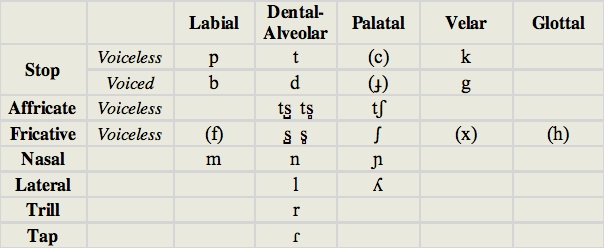
-
‣French Basque has also aspirated stops (ph, th, kh).
-
‣Palatal stops are found in some varieties of Basque: the voiceless one in some eastern dialects, the voiced one is rare.
-
‣f is severely restricted in distribution and occurs only at the beginning of a syllable.
-
‣x is found only in certain dialects.
-
‣h is not pronounced in Spain; in France it is pronounced as h in standard English.
Accent: Basque has two types of accent, western or tonal and eastern or stress-based. In the tonal system, found in Guipúzcoa and Vizcaya, the unit is the phonological phrase not the individual word. It has two patterns:
-
1.a quite flat sequence of syllables in which the first one and the last one have moderately lower and higher pitches.
-
2.the last two syllables show a diminution in pitch and intensity.
Script and Orthography. According to the Academy of the Basque language (Euskaltzaindia) the Basque alphabet has 22 letters, but an additional five (c, q, v, w, y) are used to spell words of foreign origin.

A number of digraphs are required to convey some Basque sounds:
-
tz [ts̻], ts [ts̺], tx [tʃ], ll [ʎ], rr [r], tt [c], dd [ɟ]
Morphology
Nominal and verbal morphology is essentially agglutinating, employing mostly suffixes to add grammatical information, though prefixes may be used in some verb forms to express subject and object. Suffixes are also involved in word derivation which relies on nominal and verbal compounding as well. Basque exhibits ergativity at the nominal and verbal levels.
a) Nominal
Nouns are not inflected. They are not marked for definiteness, gender. Plurality and case are marked by enclitics at the end of the nominal phrase.
gender: In Basque there is no grammatical gender, neither nouns nor adjectives differentiate gender. One exception may occur in familiar treatment when the gender of the addressee is, sometimes, expressed in the second person singular pronoun. In modern Western dialects, borrowings from Spanish retain their gender endings.
number: singular, plural. Number is not marked directly on nouns and adjectives which are invariable. Instead, it may be expressed in the noun phrase by enclitics and/or a determiner like an article, demonstrative, quantifier or indefinite pronoun.
articles: indefinite, definite. Basque uses bat (the numeral 'one') as an indefinite article; it follows the noun and is written separately. It has the plural form batzuk. For example: gizon bat ('a man'), gizon batzuk ('some men'). In contrast, the definite article is suffixed to the noun. The singular definite article is -a, and its plural is -ak. For example: gizona ('the man'), gizonak ('the men').
A noun phrase without a definite article is considered indefinite. In the indefinite phrase the noun may stand alone in certain cases but in others it may be accompanied by some determiners. The definite article is not employed:
-
•with unmodified proper nouns and kinship terms. like aita ('father'), ama ('mother'), aitona ('grandfather'), amona ('grandmother'), etc.
-
•in wishing formulas with the adjective on ('good'), like in egun on! ('good morning!'), and suerte on! ('good luck!'), etc.
-
•in adverbial phrases with instrumental or locative endings; for example in oinez ('on foot'), ahoz ('with the mouth'), beldurrez ('with fear').
-
•with cardinal numbers and other quantifiers.
-
•with interrogative and indefinite pronouns.
-
•in a genitive noun phrase followed by bat; for example in katuren bat ('some cat or other').
-
•with bare nouns that accompany the verbs: izan ('to be'), edun ('to have'), egin ('to do' or 'to make'), eman ('to give'), and hartu ('to take' or 'to receive').
When the noun phrase includes the definite article it is considered definite. However, grammatical definiteness not always coincides with semantic definiteness. For example: ijitoa means 'He saw a gypsy today', in spite of having a definite article.
case: There are two different systems of case endings in Basque, a basic system and a locative system.
The basic system has absolutive, ergative, dative, genitive, instrumental, comitative (or sociative), benefactive, and causal cases. They are expressed by suffixes attached to the noun:

Basque has full nominal ergativity marking differently the subject of transitive and intransitive verbs. The subject of transitive verbs stands in the ergative case in all types of noun phrases while the direct object of these same verbs stands in the absolutive case. In contrast, the subject of an intransitive verb stands in the absolutive.
For example, the animated noun gizon ('man') has the following basic case forms:
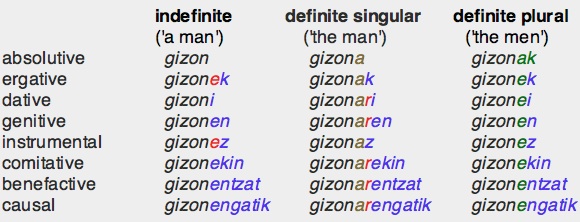
-
black: root, blue: case marker, red: euphonic insertion
-
brown: singular definite article, green: plural definite article/marker.
The base for the indefinite is the noun stem (gizon); the base for the definite singular is the noun stem + the definite article singular a (gizon-a). The absolutive definite plural is formed with the noun stem + the definite article plural ak (gizon-ak); but in the other cases the article is replaced by e (gizon-e). When the word ends in consonant, an euphonic vowel e is inserted between it and case suffixes beginning with a consonant. When the word ends in a vowel and the case suffix begins with a vowel, an euphonic r must be added between both vowels.

The locative system includes the following cases: inessive, elative (or ablative), allative, terminal, directional.
Terminal and directional cases are allative derivatives: ra + ino, and ra + antz, respectively.

Inanimate and animate nouns have different locative declensions. For example the inanimate noun ibai ('river') has the following forms:
-
black: root, blue: case marker, brown: indefinite marker, green: plural definite marker.
There are striking differences between the locative and the basic declension systems. In the locative system the indefinite is marked with the infix -ta-, placed between the noun stem and the locative suffixes; the definite singular lacks the definite article, and the definite plural inserts the infix -eta- between the stem and the locative suffixes.
When the stem ends in a consonant an euphonic vowel e is inserted between the stem and all locative suffixes of the definite singular; for example oin ('foot') has the following forms: oinean, oinetik, oinera, oineraino, oinerantz.
Animate nouns base their locatives on the genitive, and in addition they add the morpheme -gan- between the genitive base and the locative suffixes. For example, the animate noun herri ('nation') has the following locative forms:

-
black: root, purple: euphonic consonant, green: genitive marker, red: animate marker
-
blue: case marker, rose: singular definite article, brown: plural marker
adjectives: follow the noun they modify and they can be modified by adverbs of degree.
pronouns: personal, demonstrative, interrogative, indefinite.
Personal pronouns have basic, prefixed and emphatic forms. There are no 3rd person pronouns, demonstratives are used instead.
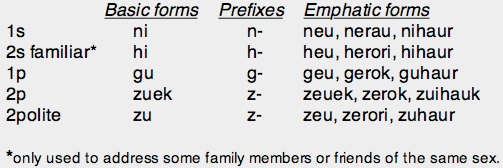
The prefixes indicate the subject of intransitive verbs and past transitive verbs while in present transitive verbs they indicate the direct object. For example the verb izan ('to be') conjugated in the present tense is naiz ('I am'); haiz ('you are'); gara ('we are'); zara ('you are' [pl.]). The emphatic forms may be used alone or accompanying the basic pronominal forms. In western varieties of Basque the emphatic pronouns are used more frequently.

Personal pronouns are inflected for case. The reflexive gives intensity or emphasis to the genitive meaning as in English 'own' with a possessive pronoun: geure etxea ('our own house'); neure etxea ('my own house'(.
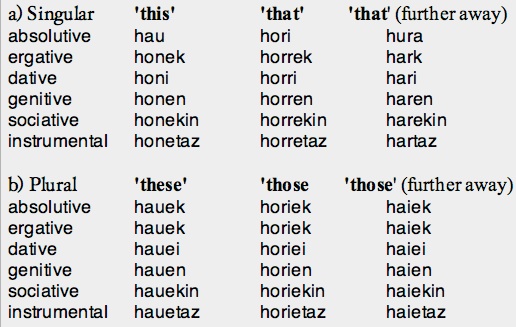
Basque has three demonstrative pronouns marking three degrees of proximity, hau ('this', closer to the speaker), hori ('that', closer to the addressee), hura ('that', far from speaker and addressee). They may be used as 3rd person pronouns.
Demonstratives express number. Singular cases are based on a stem different from the absolutive, in contrast with the plural cases that are based on it.
Demonstrative adverbs have also three deictic degrees: hemen ('here'), hor ('there'), han ('over there').
Interrogative pronouns: nor ('who?'), zein ('which?'), zer ('what ?'). They can take postpositions and form postpositional phrases: nor-en ('whose'), zein-etatik ('from which'), zer-tan ('in what'). Interrogative adverbs are, for instance, non ('where?'), and noiz ('when?').
-
b)Verbal
Basque verbal morphology is extraordinarily rich. The majority of verbs have periphrastic conjugations, inflecting by means of an auxiliary verb. The number of verbs which can inflect synthetically, i.e. without an auxiliary, is very small. In the earlier stages of the language there was a larger number of them than in modern spoken Basque. Today they are, mainly, restricted to the literary language. The citation form of a verb is its perfect participle.
transitiveness: Basque verbs can be transitive or intransitive, the former have an object(s), while the latter don't have any. On the verbs themselves there is no marking of transitivity, they differ in the case marking of their arguments, and also in the auxiliary verb they take.
In transitive verbs the subject stands in the ergative case while the object adopts the absolutive case, but in intransitive ones the subject is marked with the absolutive case. Transitive verbs take the auxiliary verb ukan ('to have') and intransitive ones the verb izan ('to be'). Izan is also the copular verb used with predicates expressing a state or condition. Verbs, in general, agree with their subjects and objects (direct and indirect) in person and number.
aspect: perfective, imperfective, unrealized. Synthetic verbs have no overt aspect marker. In periphrastic verbs, aspect is marked on participles by suffixes attached to the verbal root (see non-finite forms).
Perfective aspect indicates a completed event, the imperfective an ongoing, habitual or iterative action, the unrealized an action that has not started yet.
tense: simple present, simple past, present imperfective, past imperfective, present perfective, past perfective, future, future in the past.
The first two tenses are synthetic or simple (i.e., they don't require an auxiliary verb), while the other six are periphrastic or compound (i.e., they require an auxiliary verb).
The simple tenses are used to convey actual facts not affected by the flow of time, in other words they lack a particular aspect. Only about two dozen verbs may be conjugated in the simple tenses; all the others require an auxiliary and, thus, can only be conjugated in a compound tense. Among the synthetic verbs we find: egon ('to stay'), joan ('to go'), etorri ('to arrive'), ibili ('to walk'), izan ('to be'), jakin ('to know'), ukan ('to have'), ekarri ('to bring'), eraman ('to take'), etorri ('to come'), ibili ('to go, to wander').
Conjugation of intransitive verbs is quite different form that of transitive ones.
-
a)Intransitive synthetic conjugations
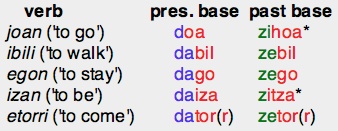
Each verb has one basic form for the present tense and another one for the past tense. They are obtained by replacing the first letter of the verbal stem by the prefixes d(a)-, marker of the present tense, and z(e)-, marker of the past tense. Some examples of present and past bases of intransitive verbs are shown in the table.
-
red: verb stem; blue: present tense marker; green: past tense marker.
* in zihoa and zitza the introduction of h, and the change from z to tz, respectively, are due to phonological rules.
The present tense third singular is the present base, i.e. it lacks a personal marker. The third plural derives from the third singular by adding one of eight possible pluralizer suffixes (-z, -tza, -de, -ir, etc) to it. The remaining persons are marked by the single-consonant personal prefixes which replace the initial consonant of the base. All plural forms have the characteristic pluralizer of the verb. Izan ('to be') is irregular in the present and past tenses.
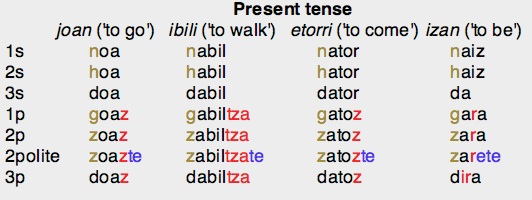
-
brown: personal marker, black: verb base, red: pluralizer, blue: polite marker.
The past tense third singular is the past base followed by the past marker -(e)n. As in the present, the third plural derives from the third singular by adding a pluralizer affix, and the remaining persons are marked by the personal prefixes which replace the initial consonant of the base. However, there is an important difference between past and present: in the past tense, the first and second persons (those that carry a personal prefix) add an n after the first vowel of the base, which is always i/e, giving in/en.
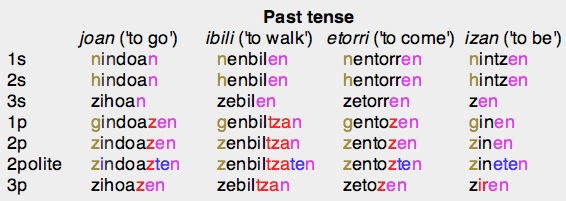
-
brown: personal marker, black: verb base, red: pluralizer, blue: polite marker, rose: past tense marker.
-
b)Transitive synthetic conjugations
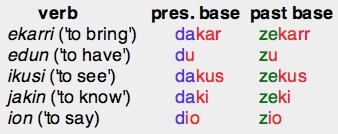
-
red: verb stem; blue: present tense marker; green: past tense marker
The present third person singular is identical to the present base while the past third singular is identical to the past base followed by the past marker -(e)n. In the present, the subject is marked by a set of personal suffixes different from the personal prefixes employed for intransitive verbs. A third person object is not marked but first and second person objects are marked by the personal prefixes used by intransitive verbs (see later). In contrast, the past tense of transitive verbs is formed in a similar way to that of intransitive ones: the subject is marked by personal prefixes while the object is not marked at all.
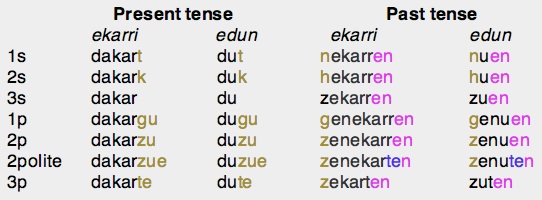
Let's see now the present and past tenses of ekarri ('to bring') and edun ('to have') with a third person direct object (which is not marked):
brown: subject markers
black: verb base
blue: polite marker
rose: past tense marker
As we have seen, a third person direct object is not marked in the present tense, but first and second person direct objects are marked by personal prefixes. When the object is plural a pluralizer marker must be used.
-
‣For example, the verb ekarri may have the following forms: nakar (he/she brings me), hakar (he/she brings you), gakartza (he/she brings us), zakartza (he/she brings you [pl.]).
-
‣With a first person object the verb edun may have the following forms: nauk (you have me), nau (he/she has me), nauzu (you have me), naute (they have me).
-
brown: subject markers, green: object markers, black: verb base, red: plural marker,
-
c)Periphrastic conjugations
The periphrastic tenses are formed with a participle of the lexical verb (see non-finite forms) followed by the conjugated auxiliary verb izan which in the indicative has past and present tenses. As Basque has three participles, each marked for one of three possible aspects (imperfective, perfective, unrealized), six possible periphrastic conjugations arise. The imperfective markers are -ten or -tzen, the perfective ones are tu, -i, -n or ∅, the unrealized ones are -ko or -(r)en. For example (aspect markers in green):
Present imperfective
-
‣imperfective participle + present tense izan: etxean gelditzen naiz ('I am staying home')
Past imperfective
-
‣imperfective participle + past tense izan: etxean gelditzen nintzen ('I was staying home')
Present perfective
-
‣perfective participle + present tense izan: etxean gelditu naiz ('I have stayed home')
Past perfective
-
‣perfective participle + past tense izan: etxean gelditu nintzen ('I stayed home')
Future
-
‣future participle + present tense izan: etxean geldituko naiz ('I will stay home')
Future in the past
-
‣future participle + past tense izan: etxean geldituko nintzen ('I was going to stay home')
mood: indicative, subjunctive, conditional, potential, imperative.
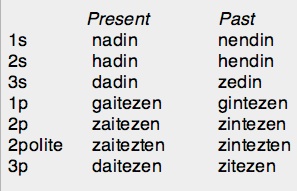
The indicative expresses a fact. The subjunctive expresses wishes, desires, purpose, requests, necessity, permission, suitability, but it is rarely used in colloquial style. The subjunctive mood has present, past and hypothetical (rare) forms in which the stem of the verb is combined with an auxiliary synthetic verb. The subjunctive of izan is:
The conditional is an hypothetical statement which is subject to certain conditions. It is formed with the unrealized aspect marker combined with the stem of the verb plus past tense forms of an auxiliary verb. For example: izango zen ('it would be'). The lexical verb izan ('to be') is followed by the unrealized aspect marker go, and the past tense, 3rd singular, of the auxiliary verb izan.
The potential expresses the capacity to become or develop into something in the future. Its forms are periphrastic, consisting of the stem of the verb plus the potential form of an auxiliary verb (like izan 'to be' or edun 'to have').
The imperative is used for commands, requests or advices. Its forms are identical to the second-person forms of the present tense from which they are distinguished by intonation.
causatives: are formed by the addition of arazi ('to cause') to the verbal root. For example:
-
ikus-arazi ('cause to see', 'show').
non finite forms: infinitive, participles (imperfective, perfective, future), verbal noun.
The infinitive is in most cases equal to the verb stem.
The different participles are formed by adding aspect-marking suffixes to the verb stem.
-
‣The imperfective participle is formed with the suffixes -ten or -tzen. It plays a role comparable to the English present participle, but it never has nominal or adjectival function.
-
‣The perfective participle may be formed with one of the following suffixes: -tu, -i, -n (or sometimes with no suffix at all). It is the citation form of all verbs. For example ibil is the stem of the verb 'to walk' and this plus the suffix i gives ibili which is the perfect participle and the citation form. The perfective participle has an adjectival nature.
-
‣The future participle may be formed with the suffixes -ko or -(r)en. The latter is restricted to the eastern dialects. For example: etorri → etorriko or etorriren; joan → joango or joanen. k changes to g after n; -ren after a vowel, -en after a consonant.
The verbal noun is formed by adding the suffix -tze (nominalizer) to the verbal root. When the verb ends in n the suffix is -te. For example the verbal noun of egon is egote, for ibili is ibiltze.
Syntax. The neutral word order in declarative sentences is Subject-Object-Verb (SOV), but it may vary. SVO is common in texts. As is the norm for SOV languages, most modifiers precede their heads and postpositions are used. However, adjectives follow the noun they modify, as well as numbers bat ('one') and bi ('two') which behave differently from other numerals.
In a noun phrase, articles follow the noun and occur only once at the end of the phrase. In affirmative sentences the lexical verb precedes the inflected auxiliary. In negative sentences the order is the opposite: adverb of negation (ez ['not'])-auxiliary verb-lexical verb.
Lexicon. Basque's core vocabulary is unrelated to any known language. However, it has borrowed many words from Latin and the Romance languages (Spanish, Occitan, French) which constitute more than 50 % of the total number of Basque's words. The native Basque vocabulary is better preserved in certain semantic domains, like: common verbs and adjectives, numerals, kinship terms, body parts, geographical terms and natural phenomena, familiar materials and tools, indigenous animals and plants. Pronouns, grammatical and affixes, are also well preserved.
Basic Vocabulary
Ordinal numbers are formed by adding the suffix -garren to the cardinal ones. Distributive quantifiers are made by adding the suffix -na to cardinal ones indicating the amount involved per individual.
one: bat
two: bi
three: hiru(r)*
four: lau(r)*
five: bost
six: sei
seven: zazpi
eight: zortzi
nine: bederatzi
ten: hamar
hundred: ehun
-
*in hirur and laur the final r drops before a consonant and at the boundary with another word; also in writing.
father: aita
mother: ama
brother: anaia
sister of a female: ahizpa
sister of a male: arreba
son: seme
daughter: alaba
head: buru
face: aurpegi
eye: begi
hand: esku
leg: hanka
foot: oin
heart: bihotz
tongue: mihi
Key Literary Works (forthcoming)
-
© 2014 Alejandro Gutman and Beatriz Avanzati
-
Further Reading
-
-Standard Basque. A Progressive Grammar. Rudolf P. G. de Rijk. MIT Press (2008).
-
-A Brief Grammar of Euskara, the Basque Language. Itziar Laka. University of the Basque Country (1996). Available online at: http://www.ehu.es/en/web/eins/basque-grammar
-
-The History of Basque. R. L. Trask. Routledge (2013).
MAIN LANGUAGE FAMILIES
LANGUAGE AREAS
Languages of Ethiopia & Eritrea
LANGUAGES by COUNTRY
LANGUAGE MAPS
-
• America
-
• Asia
-
Countries & Regions
-
-
Families
-
• Europe
-
• Oceania